Identification of Deep Tectonic Structures of the Pho Lu area, northwestern Vietnam using Digital Elevation Model and Earth focal mechanism
The digital elevation model and the earthquake focal mechanism are
utilized to define the geological structure of the Pho Lu area,
northwestern Vietnam. The results allow the identification of
lineaments and recognition of the correlation between the lineaments
and geological structures directed in the study area. The digital
elevation model (DEM) was used in the methodology of interpretation
trends of lineaments derived from various enhancing techniques to
show that the most lineament trend in the NW‒ SE direction. Further
more, the interpreted lineament map demonstrates the NW‒SE system
is correlated with the Red River fault zone, which is interpreted as a
positive flower structure combined with the focal mechanism of
earthquake. The results also demonstrate the capacity to used the
digital elevation model and focal mechanism of the earthquake to
identify deep geological structures
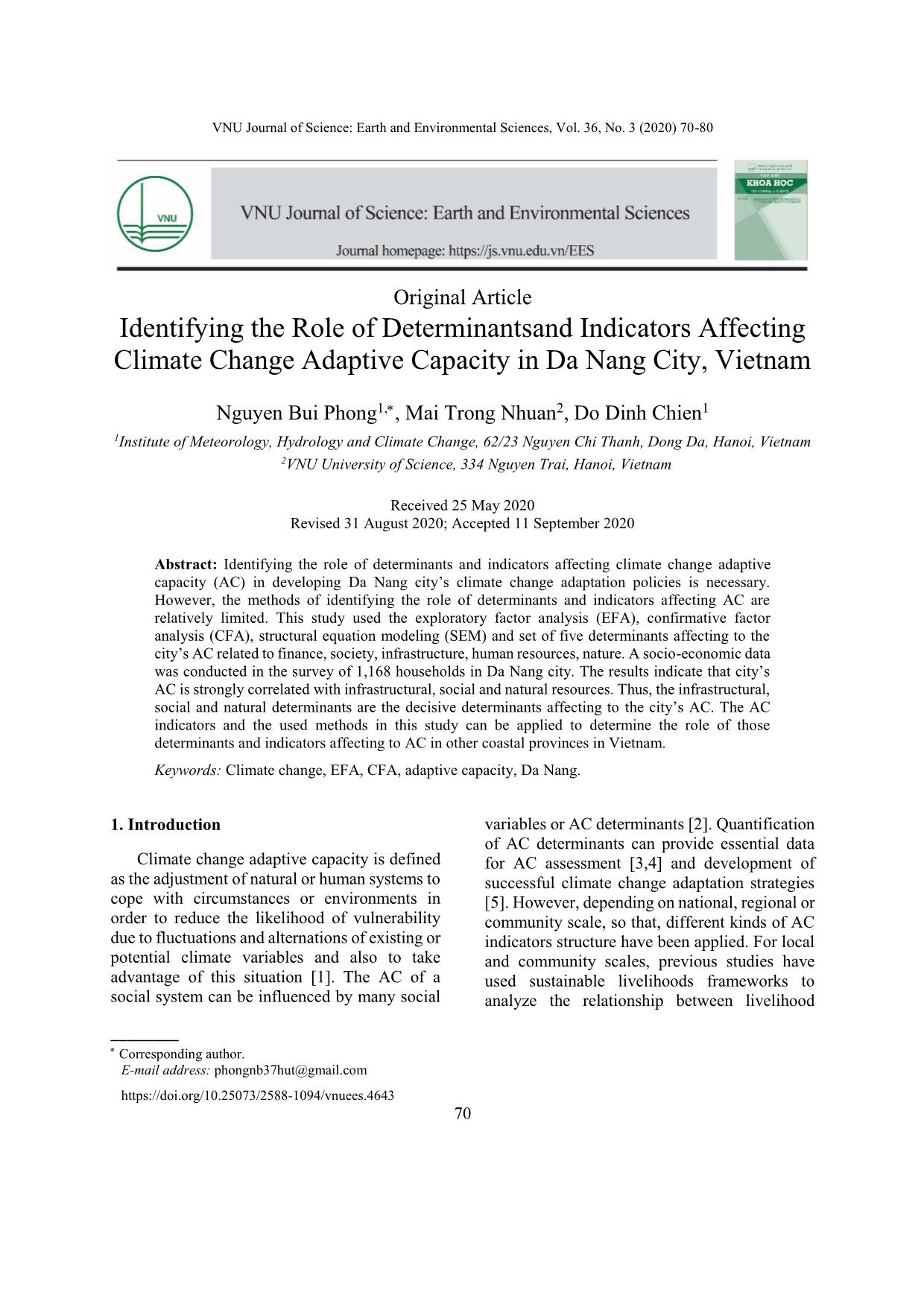
Trang 1
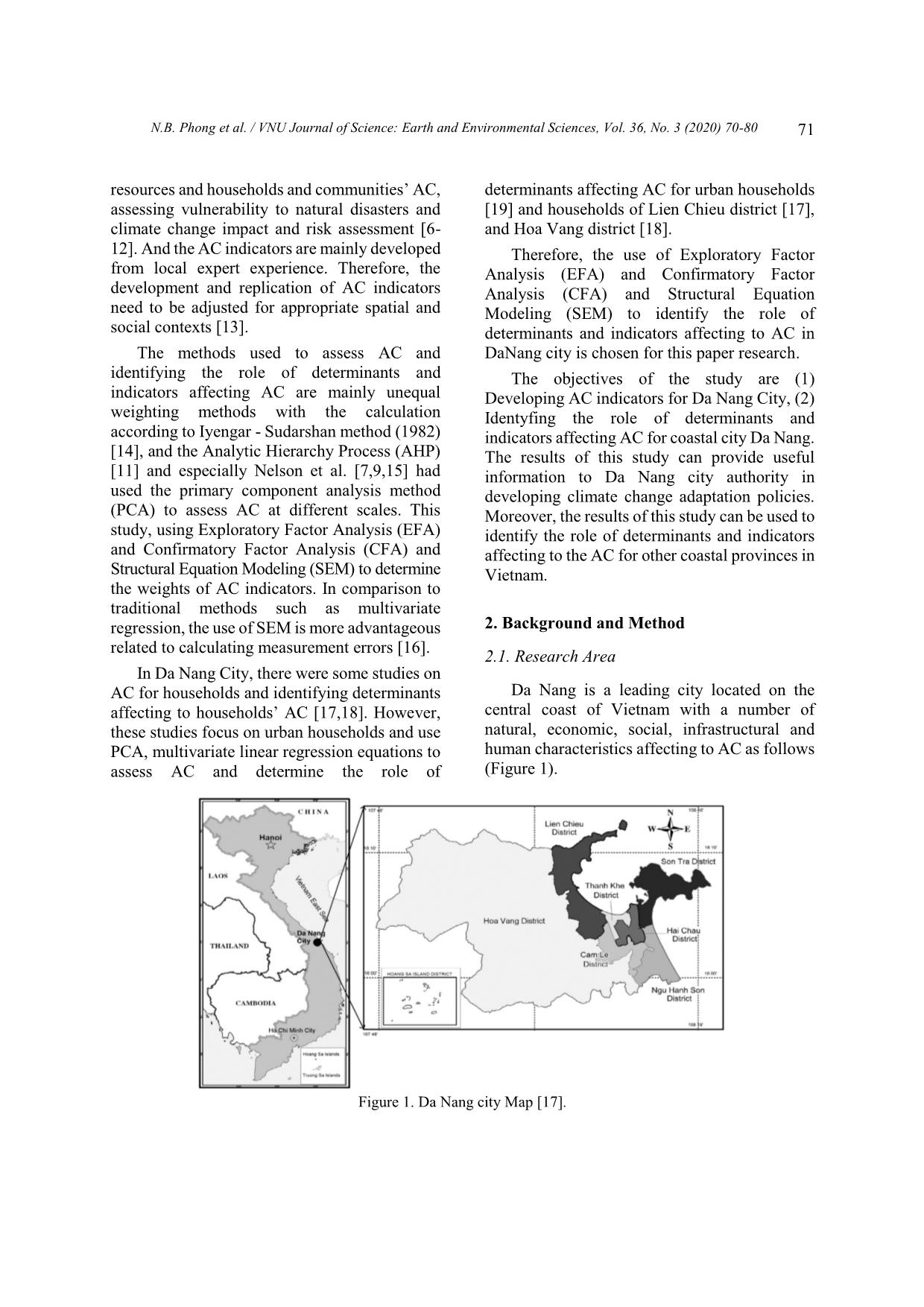
Trang 2
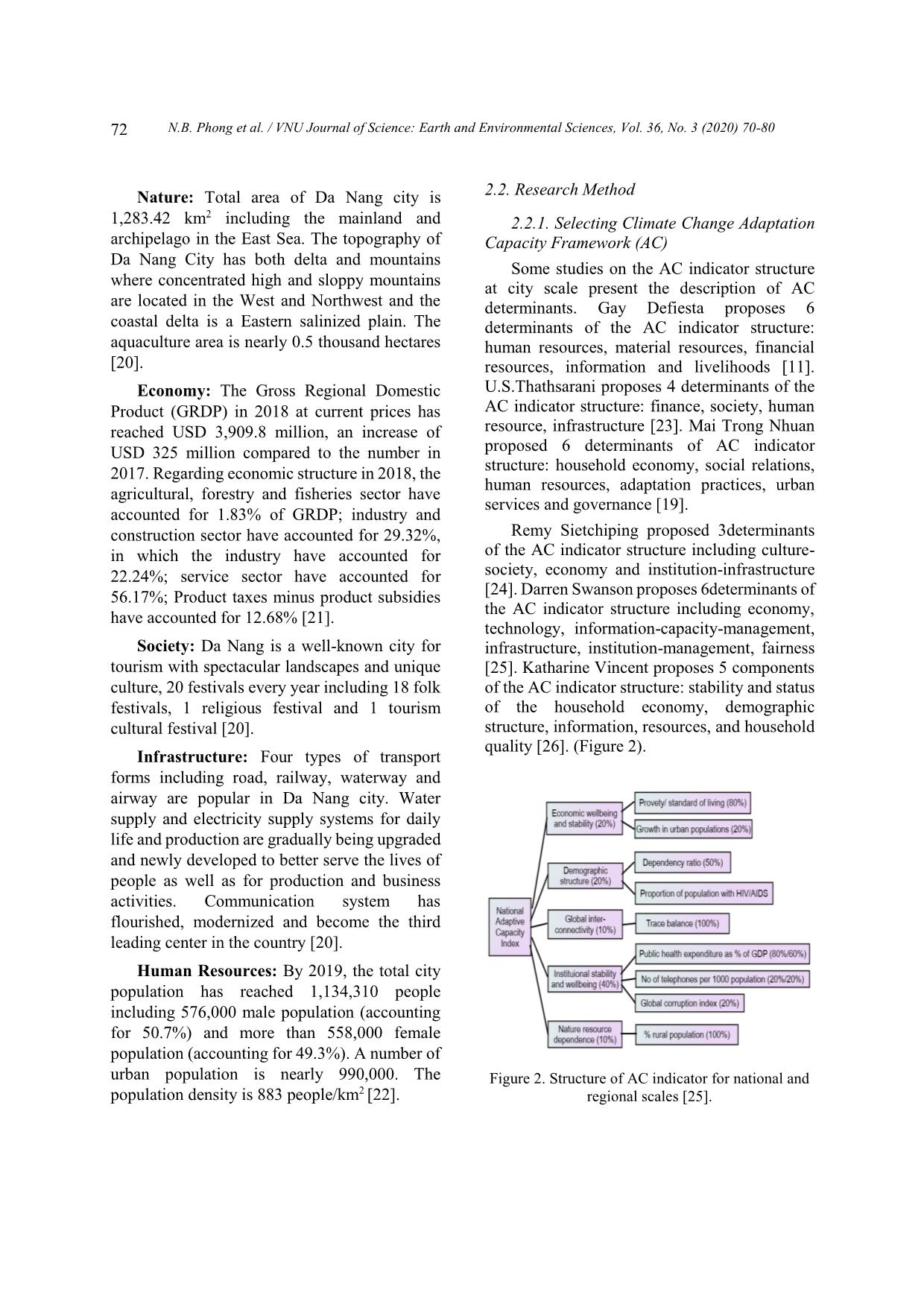
Trang 3
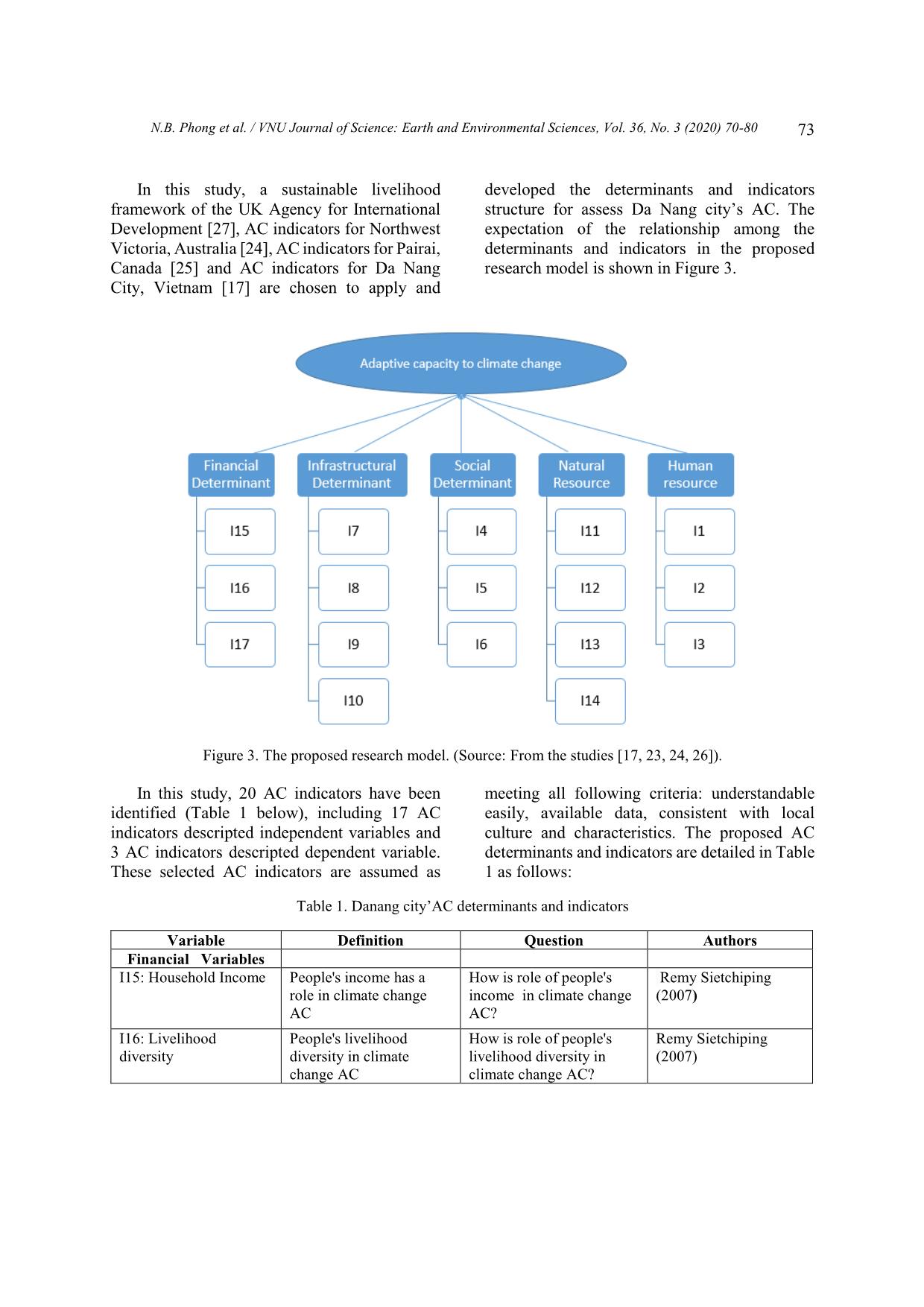
Trang 4
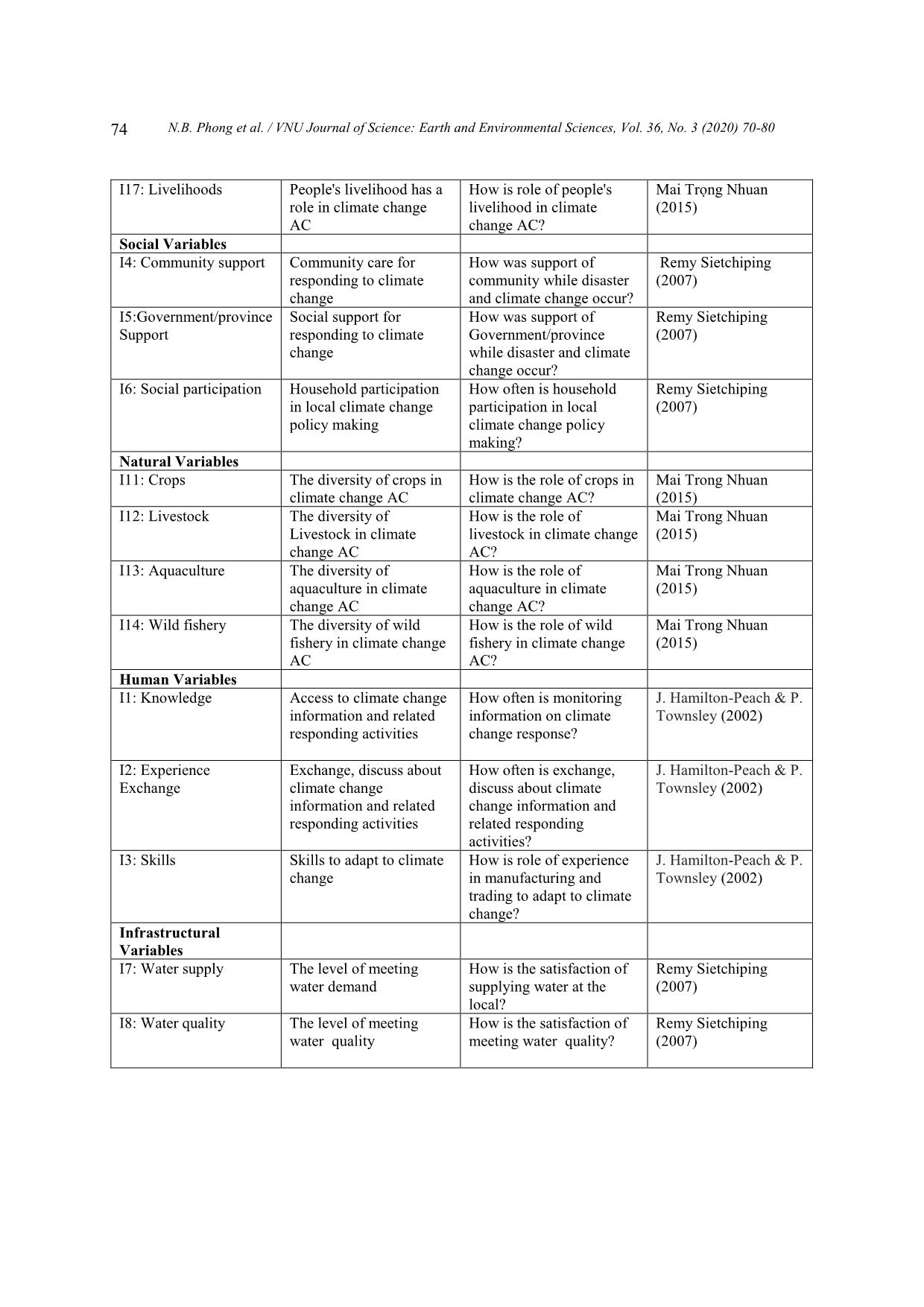
Trang 5
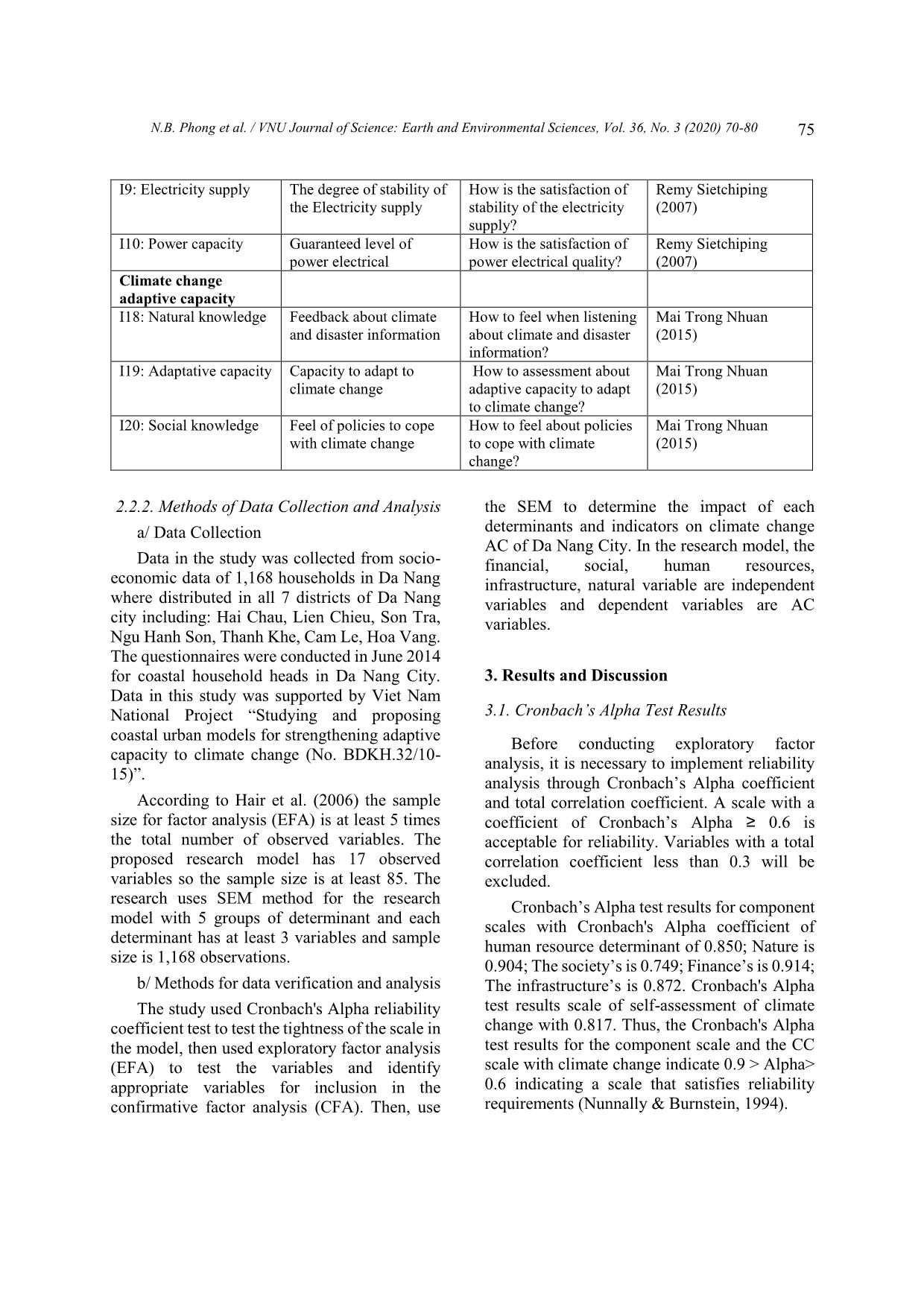
Trang 6
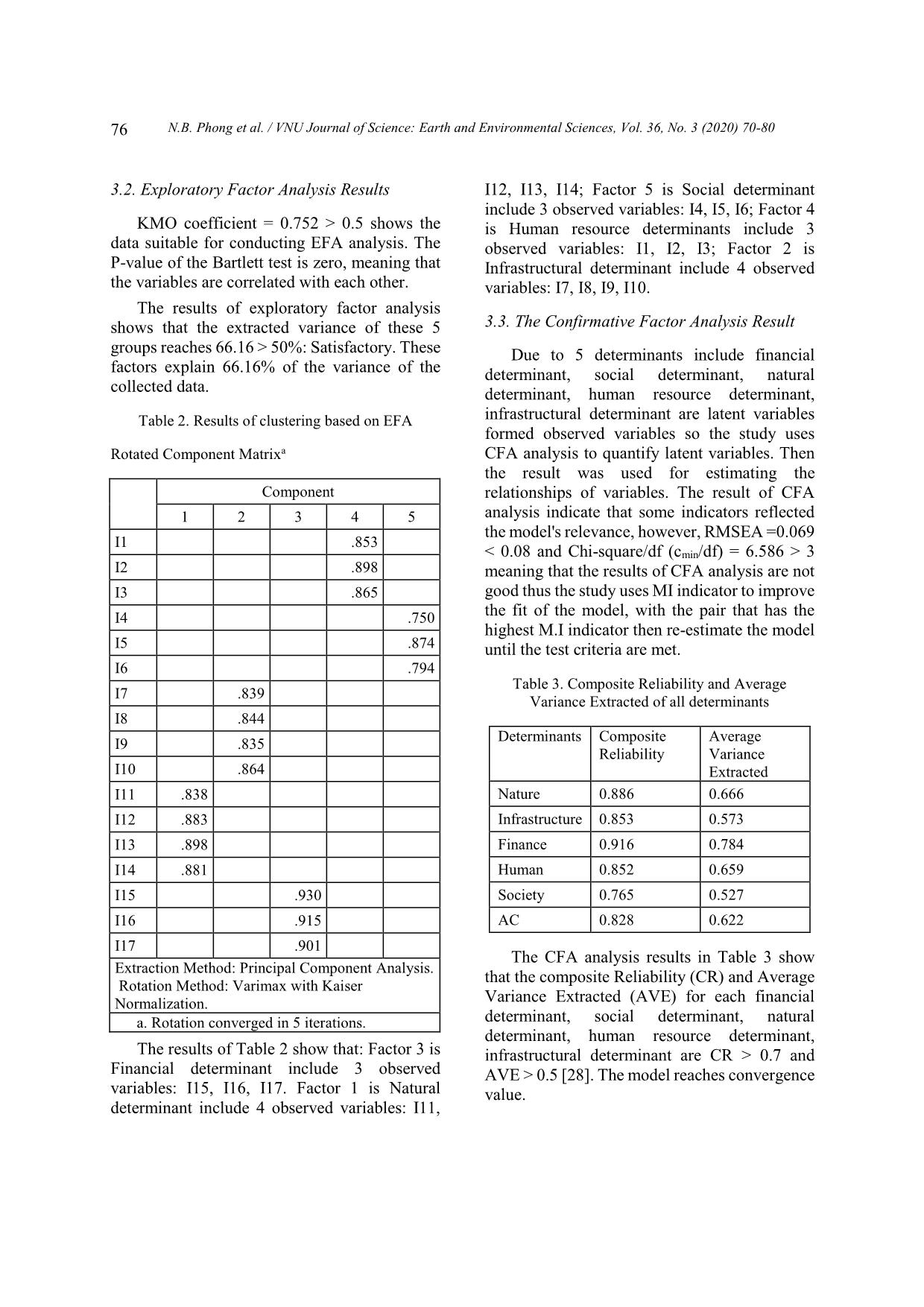
Trang 7
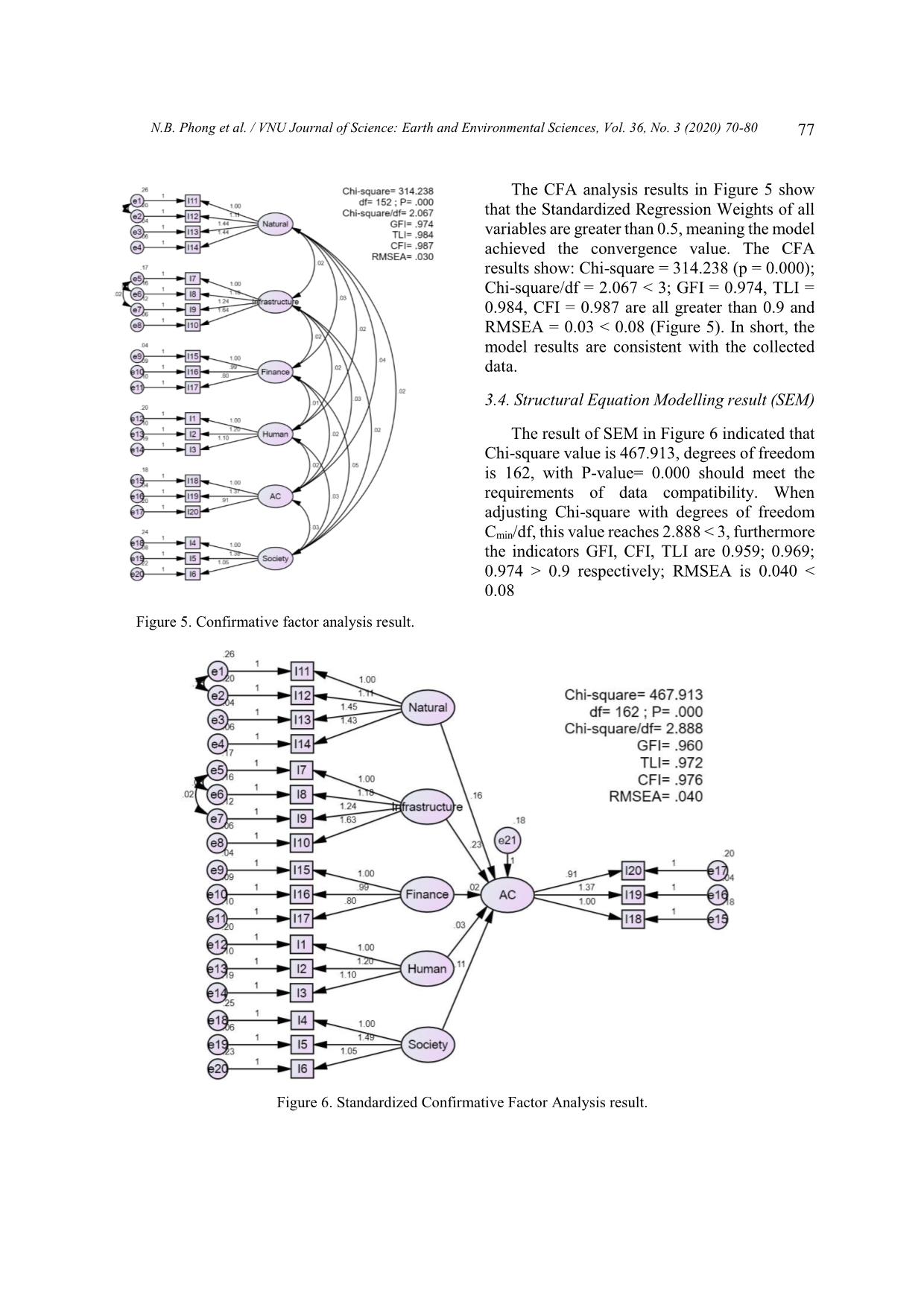
Trang 8
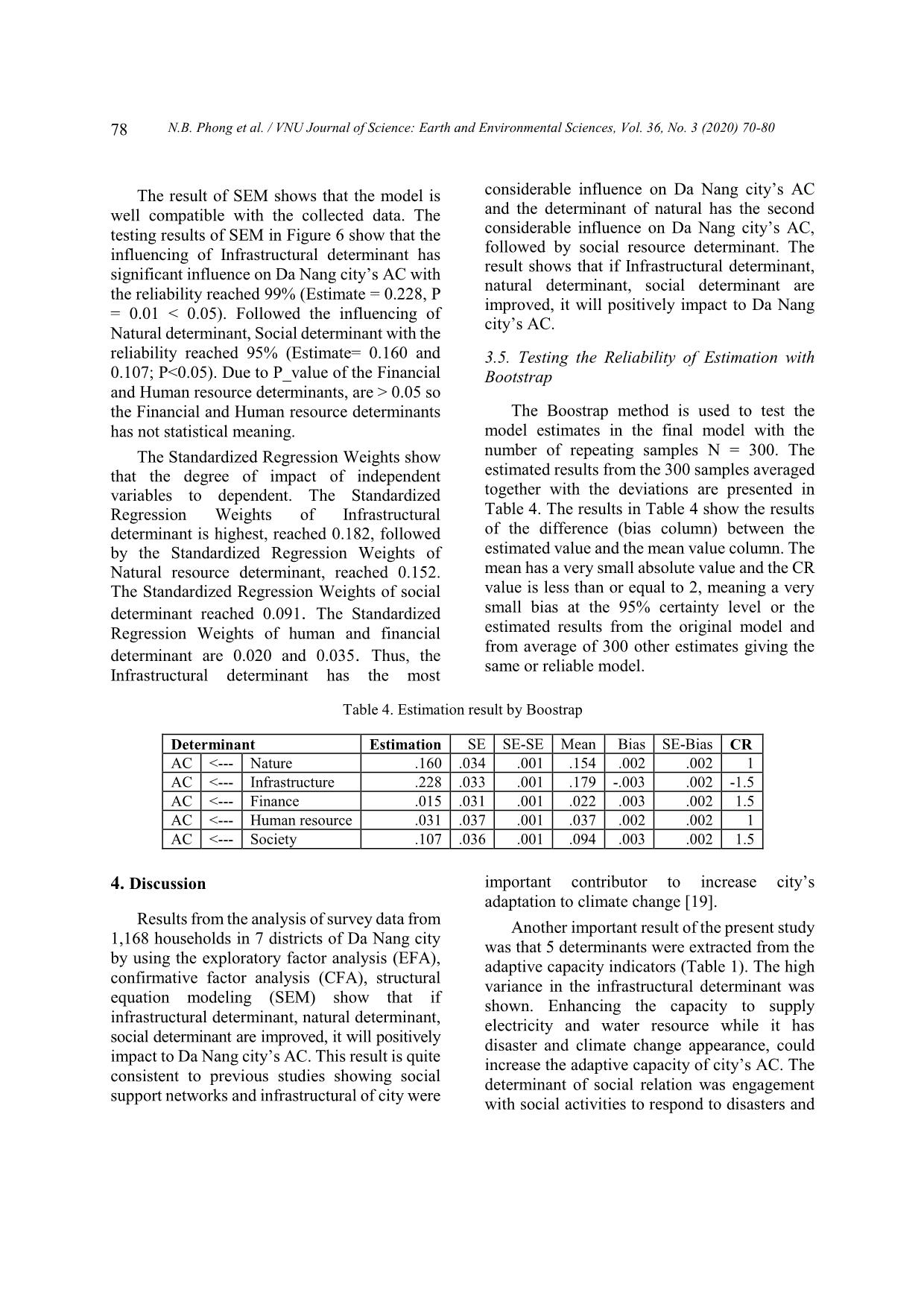
Trang 9
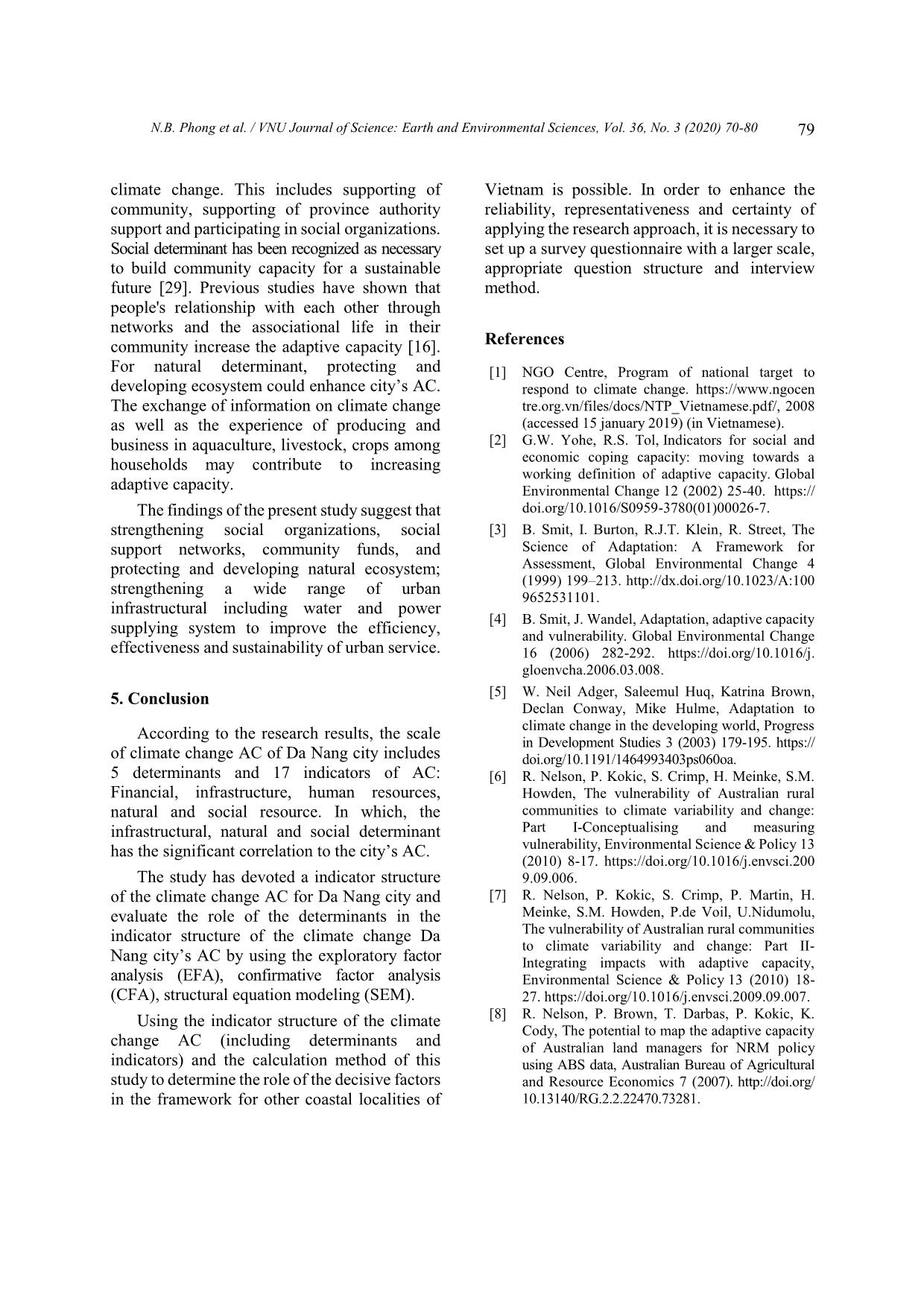
Trang 10
Tải về để xem bản đầy đủ
Tóm tắt nội dung tài liệu: Identification of Deep Tectonic Structures of the Pho Lu area, northwestern Vietnam using Digital Elevation Model and Earth focal mechanism

VNU Journal of Science: Earth and Environmental Sciences, Vol. 36, No. 3 (2020) 70-80 70 Original Article Identifying the Role of Determinantsand Indicators Affecting Climate Change Adaptive Capacity in Da Nang City, Vietnam Nguyen Bui Phong1, , Mai Trong Nhuan2, Do Dinh Chien1 1Institute of Meteorology, Hydrology and Climate Change, 62/23 Nguyen Chi Thanh, Dong Da, Hanoi, Vietnam 2VNU University of Science, 334 Nguyen Trai, Hanoi, Vietnam Received 25 May 2020 Revised 31 August 2020; Accepted 11 September 2020 Abstract: Identifying the role of determinants and indicators affecting climate change adaptive capacity (AC) in developing Da Nang city’s climate change adaptation policies is necessary. However, the methods of identifying the role of determinants and indicators affecting AC are relatively limited. This study used the exploratory factor analysis (EFA), confirmative factor analysis (CFA), structural equation modeling (SEM) and set of five determinants affecting to the city’s AC related to finance, society, infrastructure, human resources, nature. A socio-economic data was conducted in the survey of 1,168 households in Da Nang city. The results indicate that city’s AC is strongly correlated with infrastructural, social and natural resources. Thus, the infrastructural, social and natural determinants are the decisive determinants affecting to the city’s AC. The AC indicators and the used methods in this study can be applied to determine the role of those determinants and indicators affecting to AC in other coastal provinces in Vietnam. Keywords: Climate change, EFA, CFA, adaptive capacity, Da Nang. 1. Introduction Climate change adaptive capacity is defined as the adjustment of natural or human systems to cope with circumstances or environments in order to reduce the likelihood of vulnerability due to fluctuations and alternations of existing or potential climate variables and also to take advantage of this situation [1]. The AC of a social system can be influenced by many social ________ Corresponding author. E-mail address: phongnb37hut@gmail.com https://doi.org/10.25073/2588-1094/vnuees.4643 variables or AC determinants [2]. Quantification of AC determinants can provide essential data for AC assessment [3,4] and development of successful climate change adaptation strategies [5]. However, depending on national, regional or community scale, so that, different kinds of AC indicators structure have been applied. For local and community scales, previous studies have used sustainable livelihoods frameworks to analyze the relationship between livelihood N.B. Phong et al. / VNU Journal of Science: Earth and Environmental Sciences, Vol. 36, No. 3 (2020) 70-80 71 resources and households and communities’ AC, assessing vulnerability to natural disasters and climate change impact and risk assessment [6- 12]. And the AC indicators are mainly developed from local expert experience. Therefore, the development and replication of AC indicators need to be adjusted for appropriate spatial and social contexts [13]. The methods used to assess AC and identifying the role of determinants and indicators affecting AC are mainly unequal weighting methods with the calculation according to Iyengar - Sudarshan method (1982) [14], and the Analytic Hierarchy Process (AHP) [11] and especially Nelson et al. [7,9,15] had used the primary component analysis method (PCA) to assess AC at different scales. This study, using Exploratory Factor Analysis (EFA) and Confirmatory Factor Analysis (CFA) and Structural Equation Modeling (SEM) to determine the weights of AC indicators. In comparison to traditional methods such as multivariate regression, the use of SEM is more advantageous related to calculating measurement errors [16]. In Da Nang City, there were some studies on AC for households and identifying determinants affecting to households’ AC [17,18]. However, these studies focus on urban households and use PCA, multivariate linear regression equations to assess AC and determine the role of determinants affecting AC for urban households [19] and households of Lien Chieu district [17], and Hoa Vang district [18]. Therefore, the use of Exploratory Factor Analysis (EFA) and Confirmatory Factor Analysis (CFA) and Structural Equation Modeling (SEM) to identify the role of determinants and indicators affecting to AC in DaNang city is chosen for this paper research. The objectives of the study are (1) Developing AC indicators for Da Nang City, (2) Identyfing the role of determinants and indicators affecting AC for coastal city Da Nang. The results of this study can provide useful information to Da Nang city authority in developing climate change adaptation policies. Moreover, the results of this study can be used to identify the role of determinants and indicators affecting to the AC for other coastal provinces in Vietnam. 2. Background and Method 2.1. Research Area Da Nang is a leading city located on the central coast of Vietnam with a number of natural, economic, social, infrastructural and human characteristics affecting to AC as follows (Figure 1). Figure 1. Da Nang city Map [17]. N.B. Phong et al. / VNU Journal of Science: Earth and Environmental Sciences, Vol. 36, No. 3 (2020) 70-80 72 Nature: Total area of Da Nang city is 1,283.42 km2 including the mainland and archipelago in the East Sea. The topography of Da Nang City has both delta and mountains where concentrated high and sloppy mountains are located in the West and Northwest and the coastal delta is a Eastern salinized plain. The aquaculture area is nearly 0.5 thousand hectares [20]. Economy: The Gross Regional Domestic Product (GRDP) in 2018 at current prices has reached USD 3,909.8 million, an increase of USD 325 million compare ... financial determinant, social determinant, natural determinant, human resource determinant, infrastructural determinant are CR > 0.7 and AVE > 0.5 [28]. The model reaches convergence value. N.B. Phong et al. / VNU Journal of Science: Earth and Environmental Sciences, Vol. 36, No. 3 (2020) 70-80 77 Figure 5. Confirmative factor analysis result. The CFA analysis results in Figure 5 show that the Standardized Regression Weights of all variables are greater than 0.5, meaning the model achieved the convergence value. The CFA results show: Chi-square = 314.238 (p = 0.000); Chi-square/df = 2.067 < 3; GFI = 0.974, TLI = 0.984, CFI = 0.987 are all greater than 0.9 and RMSEA = 0.03 < 0.08 (Figure 5). In short, the model results are consistent with the collected data. 3.4. Structural Equation Modelling result (SEM) The result of SEM in Figure 6 indicated that Chi-square value is 467.913, degrees of freedom is 162, with P-value= 0.000 should meet the requirements of data compatibility. When adjusting Chi-square with degrees of freedom Cmin/df, this value reaches 2.888 < 3, furthermore the indicators GFI, CFI, TLI are 0.959; 0.969; 0.974 > 0.9 respectively; RMSEA is 0.040 < 0.08 Figure 6. Standardized Confirmative Factor Analysis result. N.B. Phong et al. / VNU Journal of Science: Earth and Environmental Sciences, Vol. 36, No. 3 (2020) 70-80 78 The result of SEM shows that the model is well compatible with the collected data. The testing results of SEM in Figure 6 show that the influencing of Infrastructural determinant has significant influence on Da Nang city’s AC with the reliability reached 99% (Estimate = 0.228, P = 0.01 < 0.05). Followed the influencing of Natural determinant, Social determinant with the reliability reached 95% (Estimate= 0.160 and 0.107; P<0.05). Due to P_value of the Financial and Human resource determinants, are > 0.05 so the Financial and Human resource determinants has not statistical meaning. The Standardized Regression Weights show that the degree of impact of independent variables to dependent. The Standardized Regression Weights of Infrastructural determinant is highest, reached 0.182, followed by the Standardized Regression Weights of Natural resource determinant, reached 0.152. The Standardized Regression Weights of social determinant reached 0.091. The Standardized Regression Weights of human and financial determinant are 0.020 and 0.035. Thus, the Infrastructural determinant has the most considerable influence on Da Nang city’s AC and the determinant of natural has the second considerable influence on Da Nang city’s AC, followed by social resource determinant. The result shows that if Infrastructural determinant, natural determinant, social determinant are improved, it will positively impact to Da Nang city’s AC. 3.5. Testing the Reliability of Estimation with Bootstrap The Boostrap method is used to test the model estimates in the final model with the number of repeating samples N = 300. The estimated results from the 300 samples averaged together with the deviations are presented in Table 4. The results in Table 4 show the results of the difference (bias column) between the estimated value and the mean value column. The mean has a very small absolute value and the CR value is less than or equal to 2, meaning a very small bias at the 95% certainty level or the estimated results from the original model and from average of 300 other estimates giving the same or reliable model. Table 4. Estimation result by Boostrap Determinant Estimation SE SE-SE Mean Bias SE-Bias CR AC <--- Nature .160 .034 .001 .154 .002 .002 1 AC <--- Infrastructure .228 .033 .001 .179 -.003 .002 -1.5 AC <--- Finance .015 .031 .001 .022 .003 .002 1.5 AC <--- Human resource .031 .037 .001 .037 .002 .002 1 AC <--- Society .107 .036 .001 .094 .003 .002 1.5 4. Discussion Results from the analysis of survey data from 1,168 households in 7 districts of Da Nang city by using the exploratory factor analysis (EFA), confirmative factor analysis (CFA), structural equation modeling (SEM) show that if infrastructural determinant, natural determinant, social determinant are improved, it will positively impact to Da Nang city’s AC. This result is quite consistent to previous studies showing social support networks and infrastructural of city were important contributor to increase city’s adaptation to climate change [19]. Another important result of the present study was that 5 determinants were extracted from the adaptive capacity indicators (Table 1). The high variance in the infrastructural determinant was shown. Enhancing the capacity to supply electricity and water resource while it has disaster and climate change appearance, could increase the adaptive capacity of city’s AC. The determinant of social relation was engagement with social activities to respond to disasters and N.B. Phong et al. / VNU Journal of Science: Earth and Environmental Sciences, Vol. 36, No. 3 (2020) 70-80 79 climate change. This includes supporting of community, supporting of province authority support and participating in social organizations. Social determinant has been recognized as necessary to build community capacity for a sustainable future [29]. Previous studies have shown that people's relationship with each other through networks and the associational life in their community increase the adaptive capacity [16]. For natural determinant, protecting and developing ecosystem could enhance city’s AC. The exchange of information on climate change as well as the experience of producing and business in aquaculture, livestock, crops among households may contribute to increasing adaptive capacity. The findings of the present study suggest that strengthening social organizations, social support networks, community funds, and protecting and developing natural ecosystem; strengthening a wide range of urban infrastructural including water and power supplying system to improve the efficiency, effectiveness and sustainability of urban service. 5. Conclusion According to the research results, the scale of climate change AC of Da Nang city includes 5 determinants and 17 indicators of AC: Financial, infrastructure, human resources, natural and social resource. In which, the infrastructural, natural and social determinant has the significant correlation to the city’s AC. The study has devoted a indicator structure of the climate change AC for Da Nang city and evaluate the role of the determinants in the indicator structure of the climate change Da Nang city’s AC by using the exploratory factor analysis (EFA), confirmative factor analysis (CFA), structural equation modeling (SEM). Using the indicator structure of the climate change AC (including determinants and indicators) and the calculation method of this study to determine the role of the decisive factors in the framework for other coastal localities of Vietnam is possible. In order to enhance the reliability, representativeness and certainty of applying the research approach, it is necessary to set up a survey questionnaire with a larger scale, appropriate question structure and interview method. References [1] NGO Centre, Program of national target to respond to climate change. https://www.ngocen tre.org.vn/files/docs/NTP_Vietnamese.pdf/, 2008 (accessed 15 january 2019) (in Vietnamese). [2] G.W. Yohe, R.S. Tol, Indicators for social and economic coping capacity: moving towards a working definition of adaptive capacity. Global Environmental Change 12 (2002) 25-40. https:// doi.org/10.1016/S0959-3780(01)00026-7. [3] B. Smit, I. Burton, R.J.T. Klein, R. Street, The Science of Adaptation: A Framework for Assessment, Global Environmental Change 4 (1999) 199–213. 9652531101. [4] B. Smit, J. Wandel, Adaptation, adaptive capacity and vulnerability. Global Environmental Change 16 (2006) 282-292. https://doi.org/10.1016/j. gloenvcha.2006.03.008. [5] W. Neil Adger, Saleemul Huq, Katrina Brown, Declan Conway, Mike Hulme, Adaptation to climate change in the developing world, Progress in Development Studies 3 (2003) 179-195. https:// doi.org/10.1191/1464993403ps060oa. [6] R. Nelson, P. Kokic, S. Crimp, H. Meinke, S.M. Howden, The vulnerability of Australian rural communities to climate variability and change: Part I-Conceptualising and measuring vulnerability, Environmental Science & Policy 13 (2010) 8-17. https://doi.org/10.1016/j.envsci.200 9.09.006. [7] R. Nelson, P. Kokic, S. Crimp, P. Martin, H. Meinke, S.M. Howden, P.de Voil, U.Nidumolu, The vulnerability of Australian rural communities to climate variability and change: Part II- Integrating impacts with adaptive capacity, Environmental Science & Policy 13 (2010) 18- 27. https://doi.org/10.1016/j.envsci.2009.09.007. [8] R. Nelson, P. Brown, T. Darbas, P. Kokic, K. Cody, The potential to map the adaptive capacity of Australian land managers for NRM policy using ABS data, Australian Bureau of Agricultural and Resource Economics 7 (2007). 10.13140/RG.2.2.22470.73281. N.B. Phong et al. / VNU Journal of Science: Earth and Environmental Sciences, Vol. 36, No. 3 (2020) 70-80 80 [9] G.A. Gbetibouo, C. Ringler, Mapping South African farming sector vulnerability to climate change and variability, International food policy research institute, Washington, (2009). https:// ebrary.ifpri.org/utils/getfile/collection/p15738coll2/ id/26199/filename/26200.pdf. [10] P.A. Agyei, E.D.G. Fraser, A.J. Dougill, L.C. Stringer, E. Simelton, Mapping the vulnerability of crop production to drought in Ghana using rainfall, yield and socioeconomic data, Applied Geography 32 (2012) 324-334. https://doi.org/10. 1016/j.apgeog. 2011.06.010. [11] G. Defiesta, C.L. Rapera, Measuring Adaptive Capacity of Farmers to Climate Change and Variability: Application of a Composite Index to an Agricultural Community in the Philippines, Journal of Environmental Science and Management 17 (2014) 48-62. [12] K. Williges, R. Mechler, P. Bowyer, J. Balkovic, Towards an assessment of adaptive capacity of the European agricultural sector to droughts, Climate Services 7 (2017) 47-63.https://doi.org/10.1016/ j.cliser.2016.10.003. [13] E. Wall, K. Marzall, Adaptive Capacity for Climate Change in Canadian Rural Communities, Local Environment 11 (2006) 373-397. https://doi.org/10.1080/13549830600785506. [14] C.T. Van, N.T. Son, T.N. Anh, N.C. Tuan, Developing flood vulnerability index using decentralized system analysis (AHP) - Testing for several commune units Quang Nam province in Thu Bon river delta. Journal of Meteorology and Hydrology 643 (2014) 10-18 (in Vietnamese). [15] D.J. Abson, A.J. Dougill, L.C. Stringer, Using Principal Component Analysis for information- rich socio-ecological vulnerability mapping in Southern Africa. Applied Geography 35 (2012) 515-524. https://doi.org/10.1016/j. apgeog.2012. 08.004. [16] N.D. Tho, N.T.M. Trang, Application of SEM linear structure mode - Marketing Science research, Ho Chi Minh City National University, Ho Chi Minh City (2011). [17] M.T. Nhuan, Assessing the adaptative capacity of Coastal Urban Household to climate change, Case study in Lien Chieu district, DaNang city, Viet Nam, VNU Journal of Science: Earth and Environmental Sciences31 (2015) 23-35 (inVietnamese). https://js.vnu.edu.vn/EES/article/ view/206. [18] N.T. Hao, N.T. Tue, T.D. Quy, N.D. Hoai, M.T. Nhuan, Assessment of climate change adaptation capacity for household in Hoa Vang district, DaNang city, VNU Journal of Science: Earth and Environmental Sciences 32(2016) 140-152 (inVietnamese). https://js.vnu.edu.vn/EES/article/ view/3022. [19] M.T. Nhuan, NT. Tue, N.T.H. Hue, T.D. Quy, T.M. Lieu, An indicator-based approach to quantifying the adaptive capacity of urban households: The case of Da Nang city, Central Vietnam Urban Climate 15 (2016) 60-69. https://doi.org/10.1016/j.uclim. 2016.01.002. [20] DaNang Authority’s Official Website, Danang Infrastructure https://www.danang.gov.vn/web/ en/detail?id=26033&_c=16407111, 2019 (accessed 20, January 2020). [21] DaNang ‘s Socio-Economic Annual Report, Statistical publisher, General Statistics Office, 2018. [22] DaNang General Statistics Office, Statistical publisher, General Statistics Office, 2019. [23] U.S. Thathsarani, Premakumara Lokugam Hewa Gunaratne, Constructing and index to measure the Adaptive capacity to climate change in SriLanka. Procedia Engineering 212 (2018) 278–285. [24] R. Sietchiping, Applying an index of adaptive capacity to climate change in north-western Victoria, Australia, Applied GIS 2 (2006) 16.1– 16.28. [25] D. Swanson, Indicators of Adaptive Capacity to Climate Change for Agriculture in the Prairie Region of Canada, IISD, Canada, 2007. uploads/2014/05/Indicators-of-adaptive-capacity- to-climate-change-for-agriculture.pdf. [26] W.N. Adger, K. Vincent, Uncertainty in adaptive capacity, Comptes Rendus Geoscience 337 (2005) 399-410. https://doi.org/10.1016/j.crte.2004.11. 004. [27] DFID, Sustainable Livelihoods Guidance Sheets, https://www.ennonline.net/dfidsustainableliving, 2001(accessed 20, January 2020). [28] R.B. Kline, Principles and practice of structural equation modeling, 3rd edition, The Guilford Press New York, London (2005). [29] B. Smit, O. Pilifosova, From adaptation to adaptive capacity and vulnerability reduction, Climate Change, Adaptive Capacity and Development (2003) 9-28. https://doi.org/10.1142/ 97818609458160002.
File đính kèm:
 identification_of_deep_tectonic_structures_of_the_pho_lu_are.pdf
identification_of_deep_tectonic_structures_of_the_pho_lu_are.pdf

